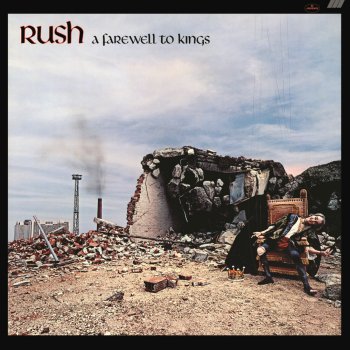
Download zip file.
Artist: Rush
Album: A Farewell to Kings
Released: September 1, 1977
Producer: Rush, Terry Brown
Genre: Progressive Rock
Rush: Tight as a Drum
"A Farewell to Kings" placed Rush among the prog rock giants.
by Paul Martz, October 18, 2016This is a review of Rush's fifth album, A Farewell to Kings. But it's really just an opportunity to talk about drumming.
Back in the '70s, when I was a kid learning how to play drums, I learned three important things from Rush's Neal Peart.
First, stay on the beat. The drummer is the band's metronome, and Peart plays with the precision of an atomic clock. As a band, Rush plays tight as a drum. While some metric sloppiness in a guitar solo or synth chord might go unnoticed, a misstep by the drummer is unforgivable.
Second, know where you are in the song. An old Hal Blaine joke goes like this: "Q: What do you call a drummer? A: Someone who hangs out with musicians." There's some truth to this, thanks to the large number of drummers who know little about song structure and arrangement. They fail to commit arrangements to memory and don't read charts or musical notation. Rush's arrangements are complex. You can't play along to these songs without knowing their structure. Peart sets an example for all drummers with his flawless execution of structural changes and sensitivity to the underlying emotion of any given passage.
Third, don't be afraid to play odd time signatures. In musical notation, a measure is a logic grouping of beats. A song's time signature is written as the number of beats in a measure over the note that signifies one beat. A common time signature is "4/4"—four beats in a measure, and a quarter note is one beat. Nearly all blues rock is in 4/4 time. For a Rush example, listen to Working Man or, from this album, Closer To The Heart, both are in 4/4.
But Rush rarely stays in 4/4. 7/8 and 11/8 are common on A Farewell to Kings and any other Rush album you care to name since Peart replaced John Rutsey on drums. Peart expertly jumps from one time signature to the next with alacrity. Such odd time signatures are the backbone of progressive rock, employed by bands such as Yes, Emerson Lake and Palmer, King Crimson, Kansas, and Van Der Graaf Generator. A Farewell to Kings placed Rush among the prog rock giants.
Speaking of King Crimson, their influence on Rush is well-documented. Peart's King Crimson analog is Bill Bruford, who pioneered progressive rock drumming while in the band Yes in the late '60s and early '70s. Comparisons between Rush with Neal Peart and King Crimson with Bill Bruford are unavoidable. Peart joined Rush in July 1974. King Crimson thinned its ranks to a trio that same year, then recorded and released Red in October. Rush went into the studio to record Fly By Night in November and December. Listen to Red and compare it to Rush's early sound. Robert Fripp and Alex Lifeson clearly have different guitar styles, and John Wetton is not Geddy Lee. But there are some striking similarities, such as use of odd time signatures and non-traditional song structure.
Side A of A Farewell to Kings opens with the title track, a triumphant anthem that mixes passages of 4/4 and 7/8. The breathtaking opening of Xanadu features a screaming Alex Lifeson guitar solo, followed by, you guessed it, a break in 7/8 time. According to Rush law, I'm required to state that Xanadu is, as every Rush-head knows, a reference to the 17th century poem Kubla Khan by Samuel Taylor Coleridge. My review is now in compliance, so relax and eat your honeydew.
There's nothing I can say about the sublime Closer To The Heart, the classic '70s-era FM radio staple and arguably their most recognizable song. There could be no better way to close out side A.
Side B opens with, frankly, a couple yawns. Cinderella Man and Madrigal appear to continue the beauty of Closer To The Heart, but fall somewhat short. They simply serve as a sort of teaser, building tension for the insane side B closer, the over-the-top prog rock classic, Cygnus X-1. If your wallpaper doesn't curl during this song, you're not playing it loud enough. The synthesized voiceover intro is followed by a percussive battery of 6/8, 7/8, and 8/8 that defies musical transcription. Lifeson's razor-sharp guitar shreds the following sequence of interposed 11/8 and 12/8 measures. Any prog rock fanatic will salivate during this song, but if you're also a musician, your eyes will roll back in your head with delirium.
I'm going to conclude with a dirty little secret. This album belongs to my wife. I owned the previous album, 2112, which I honestly prefer to A Farewell to Kings. I also owned Hemispheres and Permanent Waves. My love affair with Rush ended as they increasingly incorporated synthesizers into their music, and I sold all my Rush albums to generate extra spending money while in college. Our only surviving Rush is this album on MP3 and the Chronicles two-CD compilation.
Next: U2 - October. Previous: Killing Joke - Killing Joke. All Album Reviews.
